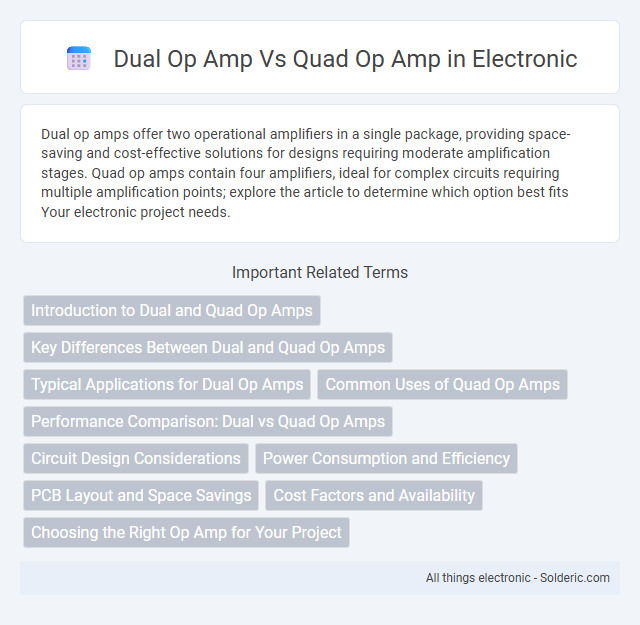Dual op amps offer two operational amplifiers in a single package, providing space-saving and cost-effective solutions for designs requiring moderate amplification stages. Quad op amps contain four amplifiers, ideal for complex circuits requiring multiple amplification points; explore the article to determine which option best fits Your electronic project needs.
Comparison Table
| Feature | Dual Op Amp | Quad Op Amp |
|---|---|---|
| Number of Amplifiers | 2 amplifiers per package | 4 amplifiers per package |
| Package Size | Smaller than quad, fewer pins | Larger package, more pins |
| Power Consumption | Lower total power per chip | Higher total power per chip |
| Common Applications | Simple circuits needing 2 amps | Complex circuits requiring 4 amps |
| Cost Efficiency | Cost-effective for 2 amplifier needs | More cost-effective when 4 amps needed |
| Typical Parts | LM358, TL072 (dual) | LM324, TL084 (quad) |
Introduction to Dual and Quad Op Amps
Dual op amps contain two operational amplifiers integrated into a single package, providing a compact and efficient solution for applications requiring multiple amplifiers. Quad op amps integrate four amplifiers in one unit, offering space-saving benefits and simplified circuit design for complex signal processing tasks. Your choice between dual and quad op amps depends on your specific circuit requirements, including space constraints and the number of amplifiers needed.
Key Differences Between Dual and Quad Op Amps
Dual op amps contain two operational amplifiers in a single package, offering a balance between functionality and space efficiency, while quad op amps integrate four amplifiers, ideal for compact circuit designs requiring multiple amplification stages. Power consumption per amplifier in dual op amps is typically lower compared to quad op amps due to fewer internal components sharing the same power supply. Your choice between dual and quad op amps depends on the complexity of your circuit, available board space, and power budget constraints.
Typical Applications for Dual Op Amps
Dual op amps are ideal for signal conditioning in sensor interfaces, audio amplification, and active filter designs where space and power efficiency are critical. They provide two independent operational amplifiers per package, making them suitable for applications such as instrumentation, data acquisition systems, and battery-powered devices. Your choice of a dual op amp can optimize circuit simplicity and performance in compact electronic projects requiring moderate channel counts.
Common Uses of Quad Op Amps
Quad op amps are commonly used in applications requiring multiple amplification stages within a compact design, such as audio mixing consoles, sensor signal conditioning, and active filters. Their integrated four operational amplifiers on a single chip reduce board space and improve circuit reliability compared to using multiple dual op amp packages. You benefit from simplified design and efficient signal processing when employing quad op amps in complex, multi-channel systems.
Performance Comparison: Dual vs Quad Op Amps
Dual op amps typically offer better performance in terms of lower noise and higher bandwidth compared to quad op amps due to separate internal compensation and optimized layouts. Quad op amps often prioritize integration and space-saving at the cost of slightly reduced gain accuracy and slew rate. Choosing between dual and quad op amps depends on the application's requirements for precision, power consumption, and board space.
Circuit Design Considerations
Dual op amps offer a compact solution for circuits requiring two amplification stages, simplifying layout and reducing component count; quad op amps integrate four amplifiers in one package, ideal for complex designs needing multiple gain blocks with minimal space. Your choice impacts power consumption, noise performance, and board real estate, as quad op amps often share power supply lines which can introduce crosstalk if not carefully managed. Evaluating the balance between channel isolation, frequency response, and footprint is essential for optimized circuit design.
Power Consumption and Efficiency
Dual op amps generally consume less power than quad op amps due to having fewer internal amplifiers operating simultaneously, making them more efficient for low-power applications. Quad op amps integrate four amplifiers on a single chip, which may increase total power consumption but can optimize space and reduce overall system power when multiple channels are required. Selecting between dual and quad op amps depends on balancing the necessary amplifier count with power budget and efficiency targets in the circuit design.
PCB Layout and Space Savings
Dual op amps require fewer PCB traces and smaller footprints compared to using two single op amps, offering moderate space savings for compact designs. Quad op amps further enhance PCB layout efficiency by consolidating four amplifiers into one package, significantly reducing board area and simplifying routing. This consolidation minimizes parasitic effects and improves signal integrity by reducing trace lengths and component spacing on densely packed PCBs.
Cost Factors and Availability
Dual op amps generally offer a cost-effective solution due to fewer pins and simpler packaging compared to quad op amps, making them more affordable for applications requiring only two amplifiers. Quad op amps, while potentially more expensive upfront, provide greater integration and space savings on your PCB by combining four amplifiers in a single package, which can reduce overall system costs in complex designs. Availability varies depending on specific models and suppliers, but dual op amps often have wider options and better stock levels, ensuring quicker procurement for your project needs.
Choosing the Right Op Amp for Your Project
Selecting the right operational amplifier depends on your project's channel requirements and space constraints; dual op amps contain two amplifiers per package, while quad op amps provide four, optimizing board layout and component count. Your choice should consider power consumption, signal integrity, and cost, as quad op amps typically consume more power but save space compared to using multiple dual op amps. Evaluating these factors ensures optimal performance and efficiency tailored to your circuit design needs.
Dual op amp vs Quad op amp Infographic

 solderic.com
solderic.com